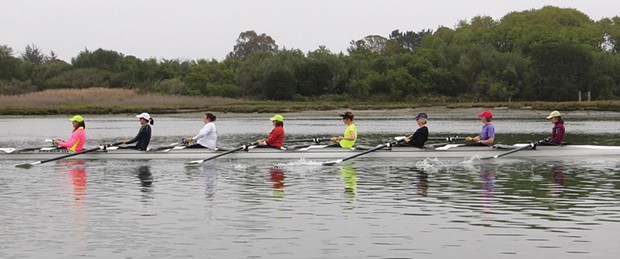[
{
"name": "Top Stories Video Pair",
"insertPoint": "7",
"component": "17087298",
"parentWrapperClass": "fdn-ads-inline-content-block",
"requiredCountToDisplay": "1"
}
]
When he gets wind of my plans to go rowing on Humboldt Bay, my husband eyeballs me sternly over his reading glasses. "Be careful." he warns. "One wrong move and you could fly out of the boat." A friend suggests I start doing pushups immediately. My mother reminds me to wear a lifejacket.
With this advice in mind, I pull up to the Humboldt Bay Rowing Association (HBRA) boathouse just south of the Samoa Bridge in Old Town. It's cold out, and a hoary fog hangs high in the early morning sky. Inside the boathouse (which is shared with Humboldt State University's Rowing Association) long, pointy boats rest neatly on racks and hang from the ceiling. Old fashioned metal lockers line the walls. Straight-backed rowing machines stand upright in a corner. With a background hum of easy banter, 20 or so people move around purposefully.
The big metal doors roll open and everyone lines up to lift the boat. There's clearly a system and timing to their movements. The coxswain, the one who sits at the front of the boat, calls out instructions. I grapple with the thing and do my part to raise the boat up and over our heads and march it out to the bay.
With the help of HBRA veteran Lorraine Dillon, I lock my oar into the rigger, screw it down and tuck my sneakers in a little hole under the sliding seat. I step carefully onto the boat in my socks. One foot, then two, and I strap into a pair of shoes that are conveniently attached to the boat. I grab the oar, hold it the way I'm told and hope I can do this with some measure of grace.
Once we get started, there's not much opportunity to absorb the natural beauty of the bay. I'm focused on the task at hand. In that moment, my world is very small. Rowing in the right direction is important, as is the tilt of the oar and the curve of my back. As I struggle to mirror the strokes of the oars alongside me, I make a mental note that this would not be a good activity for the hungover among us. All cognitive and physical faculties must be on deck to address the vigorous, multi-layered demands of rowing.
We're in an eight-seater boat called a shell. After a few sets, the rower in front of me, Laurie Clendenen, turns around and gives me a high-five. She just ran the Boston Marathon. I am astonished by the determination and strength of these women. According to the US Rowing Association website, rowing is one of the few sports that uses all of the major muscle groups and, as a result, rowers are generally thought to be the world's most physically fit athletes. The average age in the women's eight is 50-something. Dillon is the oldest at 64. She killed it out there on the bay.
The pull and sway of the strokes is grounding, and I'm struck by the value of working as a team — the disciplined camaraderie. Being part of that unified effort is invigorating. Also, my knees hurt. And I fear for my back.
After about half an hour, I shift over to the coach's motorized boat. With the beginner out of the shell, the rowers hit their stride. At one point, they pause, drop a layer of clothing and continue on their way. The coach explains that rowers don't wear lifejackets (sorry, Mom) and instead depend on the oars and boat as floatation devices should things go awry.
HBRA's mission is to promote rowing "for community members of all ages and abilities." This is reassuring. My rowing mates are consistently patient and encouraging. As a rule, I'm not particularly coordinated, nor am I athletic. But I'm feeling arguably more studly after my rowing experience. In fact, I might have to do it again.
A nonprofit established in 1989, HBRA participates in a competitive league and offers recreational programs for adults and juniors aged 11-18. If you're intrigued: good news! Saturday, June 6 is HBRA's Learn to Row Day. Hosted annually in conjunction with rowing associations nationwide, this free event provides an opportunity for the community to investigate rowing in earnest. HBRA members will be on hand from 7 a.m. to noon to teach the basics of boat safety, demonstrate rowing techniques and get you out on the water. Register for a two-hour session and find more information at www.hbra.org.
more from the author
-
NCJ Archive: The Journey of Radioman
- Nov 11, 2020
-
'In the Interest of Justice'
Decades after leaving the jungle, Eric Hollenbeck is awarded three Bronze Service Stars
- Dec 14, 2017
-
The Journey of Radioman
- Nov 9, 2017
- More »
Latest in Get Out
Readers also liked…
-
A Walk Among the Spotted Owls
- Apr 27, 2023


































